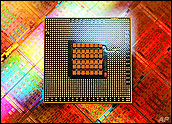
IBM and MediaTek have announced a joint effort to develop ultra-fast chipsets that will be able to blast a full-length high-definition movie faster than most people can read this sentence. For example, IBM says, a consumer could upload a 10 gigabyte file in five seconds with the new technology versus the 10 minutes it takes using current WiFi technology.
The new technology will be based on the 60 GHz (gigahertz) band, which is a free and unlicensed band of radio spectrum. Most home wireless networks utilize bands in the single-digit range, such as the popular 2.4 GHz band.
IBM and MediaTek will collaborate to integrate IBM’s new millimeter wave (mmWave) radio technology chips, antennas and package technology with MediaTek’s expertise in digital baseband and video processing chips. The partnership is also intended to leverage MediaTek’s influence in the consumer electronics market. IBM first demonstrated a prototype chipset as small as a dime in February of 2006.
A Whole New Living Room
The idea is to let media devices transmit or receive large amounts of data quickly, making the millimeter wave radio technology particularly useful for PCs, digital video recorders (DVRs), handheld devices like iPods or iPhones and HDTVs. Synchronization between the devices could occur in seconds and without a mess of cables.
Aside from speeding up home networks, there are other uses in store, such as file transfers from kiosks that a consumer might find in common retail spaces.
“[A kiosk would be] more like a point-and-shoot application,” Mehmet Soyuer, IBM lead researcher on the mmWave project, told TechNewsWorld.
“It could be used to download DVDs and movies, things like that, in a train station or airport,” he explained.
High Frequencies Are the Key
Higher frequencies — 60 GHz in this case — tend to allow greater bandwidth for data transmission than lower frequencies like the popular 2.4 GHz used in many home wireless networks. While transmission speeds at 60 GHz are super fast, “the signal doesn’t travel too far,” Soyuer noted. “It typically stays in a room, so it would be a good match for personal area network — PAN-types of applications. It’s like a much higher data rate version of Bluetooth, in some respects.”
Using higher frequencies for the transmission of very large media files is a more logical solution for wireless applications, Soyuer said. “For the application of uncompressed video, we are talking about needing two, maybe three GHz per second, and it’s almost impossible to achieve those data rates using the conventional lower frequencies,” he added.
Years Away
Wicked-fast movie downloads using IBM’s and MediaTek’s mmWave technology is a few years away. In addition to nailing down wireless networking standards — critical so that a variety of devices can talk to each other in the same language, so to speak — device manufacturers need to build and ship products with mmWave features.
Progress is happening, however. The IEEE (Institute of Electrical and Electronics Engineers) 802.15.3c is a working group that was formed in 2005 to standardize the use of the 60 GHz band.










































